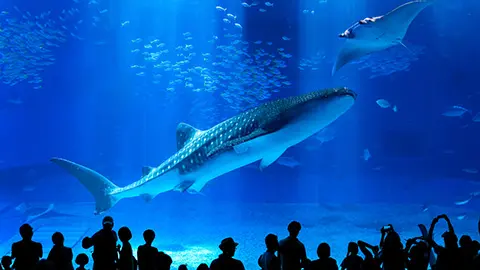VOL.196 SEPTEMBER 2024
JAPAN’S ENJOYABLE PUBLIC AQUARIUMS
Aquarium Combining Art and Living Creatures
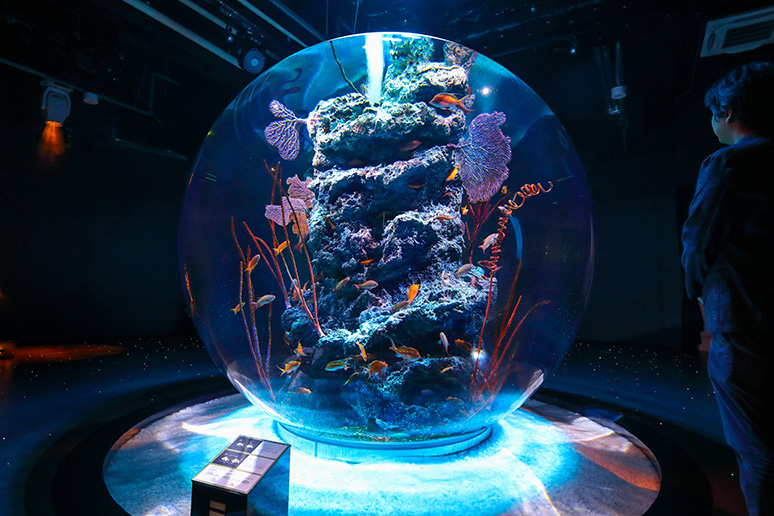
AQUA TERRA, located in the PLANETS: Miracle Planet zone, measures three meters in diameter and is one of Japan’s largest spherical aquariums.
Photo: ISHIZAWA Yoji
Kobe City in Hyogo Prefecture is home to a cutting-edge aquarium called AQUARIUM × ART átoa that combines aquarium* and art. This aquarium allows visitors to view marine life amid digital art** and the latest stage designs***. We spoke with the PR representative from the operating company to learn more about the concept and features of átoa, which combines elements of an aquarium and an art museum into one integrated experience.
Kobe City, Hyogo Prefecture, has long flourished as a port town and is a central city in the Kansai region****, alongside Osaka and Kyoto. In the Sannomiya area of Kobe, known for its large commercial facilities, redevelopment projects are underway along the waterfront. One such project is the opening of the aquarium, átoa, in 2021. Since its opening, the aquarium has already attracted two million visitors.
FUKUZAKI Fumi, the aquarium’s PR representative, describes the facility’s features: “The aquarium can be enjoyed within a space enhanced by digital art and the latest stage design. The name ‘átoa’ is a combination of the words ‘aquarium,’ ‘to’ (meaning ‘and’ in Japanese), and ‘art,’ symbolizing the fusion of aquarium and art. The eight zones each have their own themes, with symbolic tanks representing these themes and creating artistic spatial effects. Visitors can enjoy unique tanks, such as MINAMO, a glass-floored tank that gives the feeling of walking on water, and AQUA TERRA, one of Japan’s largest spherical tanks with a diameter of three meters. These tanks are enhanced with sensory experiences including sound, light, and scent, making the viewing experience more fantastical.”
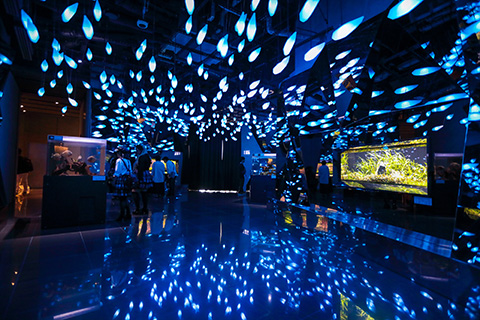
Photo: ISHIZAWA Yoji
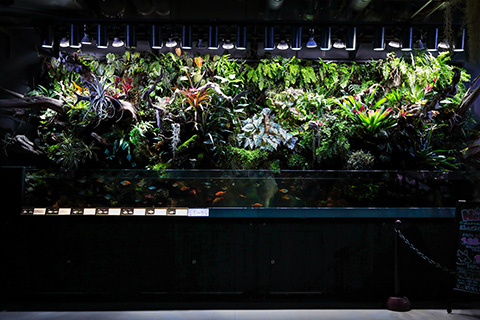
Photo: ISHIZAWA Yoji
The aquarium houses approximately 100 species and 3,000 creatures, including marine and freshwater fish, as well as life from coastal and riverside habitats. In addition to fish, there are also exhibition areas featuring capybaras***** and Asian small-clawed otters******.
“In the PLANETS: Miracle Planet zone, there is a spherical aquarium, AQUA TERRA, with a diameter of three meters, one of the largest in Japan. This space represents planet that support life , imagined within a universe surrounded by countless stars. Visitors can feel the vitality of these planets floating in space through a laser performance shown every 10 minutes and mist falling from the ceiling, which creates a deeply engaging experience,” explains FUKUZAKI.
She also mentions that the MIYABI: Between Peace and Light zone known for its traditional Japanese-style ambiance, is particularly popular not only among Japanese tourists but also among foreign visitors. “In this zone, visitors can observe varicolored carp swimming under their feet through the glass floor, as well as Japanese goldfish varieties such as Izumo Nankin and Tosakin*******. The design not only incorporates traditional Japanese crafts and stage art techniques but also adds elements of traditional scents, creating an ambiance that reflects Japan’s cultural beauty. We often hear people say it feels like walking through a Japanese garden and that every spot is picture-perfect. The space, with its light displays changing throughout the day to vividly reflect Japan’s seasonal landscapes, creates a fantastical atmosphere that has been very well received.”
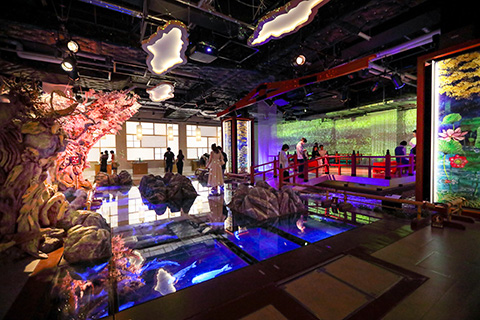

MIYABI: Between Peace and Light zone features traditional Japanese design elements and a glass-floored aquarium.
Photo: ISHIZAWA Yoji
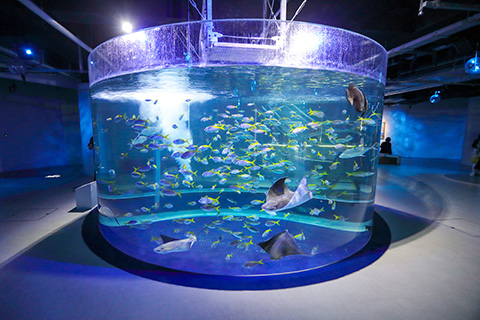
Photo: ISHIZAWA Yoji
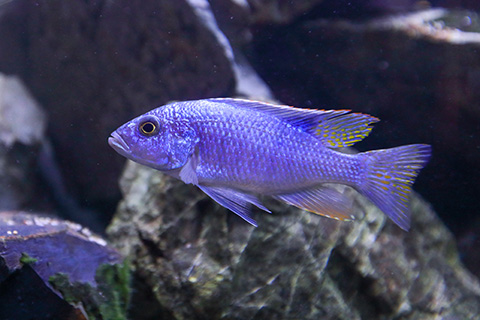
Photo: ISHIZAWA Yoji
The facility provides guidance in both Japanese and English for foreign tourists, and pamphlets are available in English, Simplified Chinese, Traditional Chinese, and Korean to accommodate international visitors.
In addition to exhibiting living creatures, the aquarium actively hosts programs focused on research related to various species. “The Asian small-clawed otters we keep are an endangered species, and we have organized programs to raise awareness about otter conservation. We will continue to hold events that deepen understanding of both living creatures and the environmental issues in the places they live,” says FUKUZAKI.
Although international visitors make up only about 1.4% of the total, they have responded positively. Some post their photos on social media, noting that each exhibition looks very photogenic, and share them with each other.
“The aquarium is located about a 20-minute walk from Sannomiya Station or Motomachi Station, which are key transportation hubs in Kobe. We hope visitors will come by while exploring the city.”
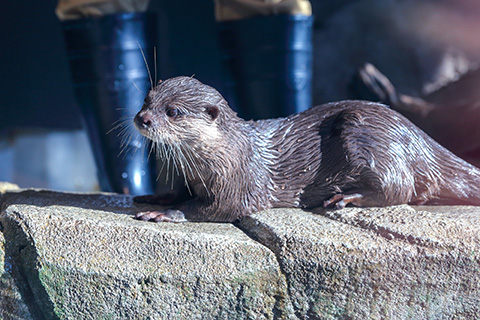

SKYSHORE: Skyside Garden: The open zone on the rooftop is popular for housing animals like the
endangered small-clawed otters and capybaras, which have been decreasing in number in
recent years.
Photo: ISHIZAWA Yoji
* Refers to the equipment used for the care of aquatic organisms. It encompasses a range of concepts from large facilities like aquariums to smaller setups for personal homes.
**Artworks created using digital devices such as computers and tablets.
*** A collective term for various elements that enhance stage expression through the audience’s visual perception and imagination in performing arts. This often includes areas such as costumes, set design, and lighting effects.
**** A collective term for the area centered around Kyoto, Osaka, and Kobe.
***** The largest rodent species, native to the riverine grasslands and wetlands of northeastern Argentina in South America.
****** A small species among the 13 types of otters, found in small rivers and irrigation channels in Southeast Asia. Recently, their population has declined, and they are classified as a vulnerable species by the International Union for Conservation of Nature and Natural Resources (IUCN).
******* A variety of goldfish bred for display purposes. The Izumo Nankin from Shimane Prefecture and the Tosakin from Kochi Prefecture are designated as natural monuments.
By TANAKA Nozomi
Photo: ISHIZAWA Yoji

